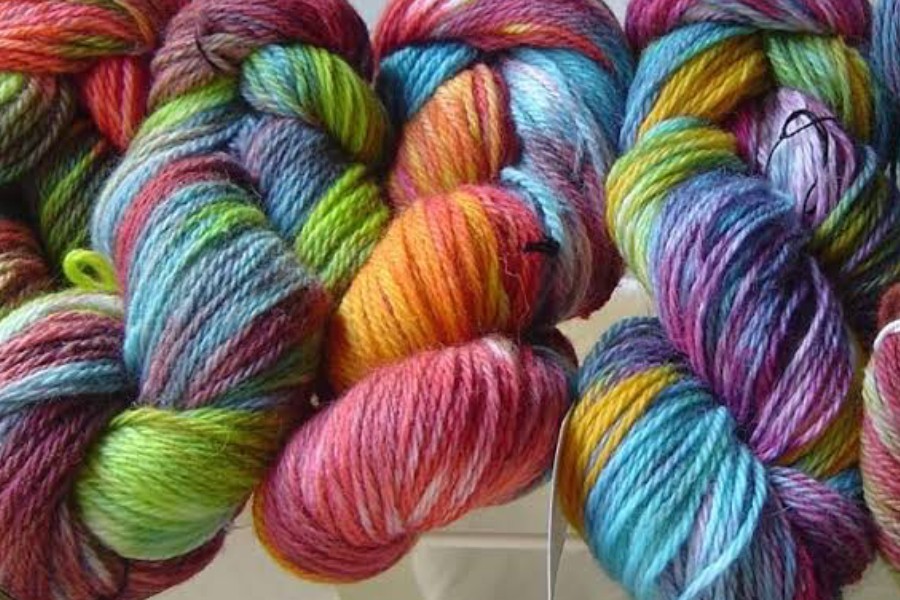Bangladesh turned into a garment-exporting nation in the late eighties of the last century. The journey is continuing with increasing momentum. However, it is said that garment export may face challenges due to upcoming products from man-made fibres. Man-made fibres are made from polymers. These are not the same as natural fibres, such as silk, cotton and wool. There are two types of man-made fibres - synthetic fibres and regenerated fibres. Regenerated fibres are made from cellulose polymers that occur naturally in plants such as cotton, wood, hemp and flax. Materials like rayon and acetate, two of the first man-made fibres to be produced were made from cellulose polymers. Here plant cellulose was taken and then made into fibres.
Synthetic fibres made only from polymers are found in natural gas and the by-products of petroleum. They include nylon, acrylics, polyurethane and polypropylene. Millions of tonnes of these fibres are produced all over the world each year.
Bangladesh's export trade is concentrated on a few products-- the single important one being readymade garments. Exports from this sector constitute more than 80 per cent of the country's total exports. It is commonly acknowledged that since the very beginning, three factors facilitated development of this sector. Of the three, two factors were--- customs bond licences and back to back LCs (BBLCs). Afterwards, cash incentive facilitated backward linkage industries of garment sector such as spinning mills, textile mills and the like. Despite development of backward linkage industries, garment sector is still dependent on imported inputs. It indicates that there are spaces to expand backward linkage industries to support readymade garments.
At the initial stage, readymade garments started operations with input sourcing from South East, East Asia and neighbouring countries. BBLCs worked as a financing tool for raw material sourcing. Earlier exporters would export goods on cash against LCs for which input procurements were executed on credit term. The trade mode has been changed over time. Exports are now executed on credit terms against sales contracts but input procurement is needed on cash under LCs. To face the situation, the central bank has extended some policy tools --- loans from export development fund (EDF) in foreign currency, and buyer's credit from offshore banking units and external sources. Moreover, there are supports like packing credit by banks, pre-shipment credit from central bank, green transformation fund (GTF), financing under SREUP (safety retrofits and environmental upgrades), and many more schemes of the central bank.
Bangladesh must take necessary preparation to move on to man-made fibres in a big way. There is a question whether it is possible to develop or convert existing production units into ones based on man-made fibres. What is to happen in case of phase-out of cotton-based garment is definitely a challenge before Bangladesh. Whatever may be the situation, preparation is needed to face the challenges.
Bangladesh is vastly experienced in garment production. Existing facilities, at the initial level, can cope with man-made fibre-based output. In this case, these fibres need to be sourced through procurement. Existing policy framework like customs bond facilities, BBLCs, buyer's credit, EDF may support the need for working capital for procurement. On the aspect of capital expenditure, the existing industries may start operations within existing facilities by injecting moderate investment. Banking system with provision for interest cap can facilitate the financing needs easily.
For backward linkage facilities, existing cotton-based industries may face many challenges. Industries need to be compatible to cope with new production for which technological advancement will be required. Capital expenditure is to be supported either by equity or loans. For the latter, financing is needed at a low cost. Technological development fund run by the central bank is a way out to support the need.
Earnings by export-oriented industries are in foreign currency. These industries can pay off liabilities in foreign currency. For conversion of industries, capital expenditure can be supported from prevailing banking system and financing facilities from the central bank. In addition, there is an option to avail of loan from external sources at reasonable cost with permission from competent authorities like the Bangladesh Investment Development Authority or the central bank. Exporters can easily repay external loan out of the foreign currency they earn against export proceeds. This will keep away exporters from incurring exchange loss.
At every step of cross border trade, challenges are there. These challenges also bring opportunities. Definitely, man-made fibre-based production can result in incremental exports compared to cotton-based one. So, challenges have to be encountered. Initiatives are to be taken primarily by the private sector. On the other hand, facilities available for readymade garment exporters need to be fine-tuned to fit into the changing situation in converting existing industries into man-made fibre-based industries. In this case, facilities like customs bond, BBLCs for input procurement, cash incentives, loans from EDF and other schemes should continue as long as possible.
It is expected that Bangladesh will be able to face challenges in the transition from cotton-based industries to man-made fibre-based industries. Challenges are ahead but they can as well be faced squarely.


